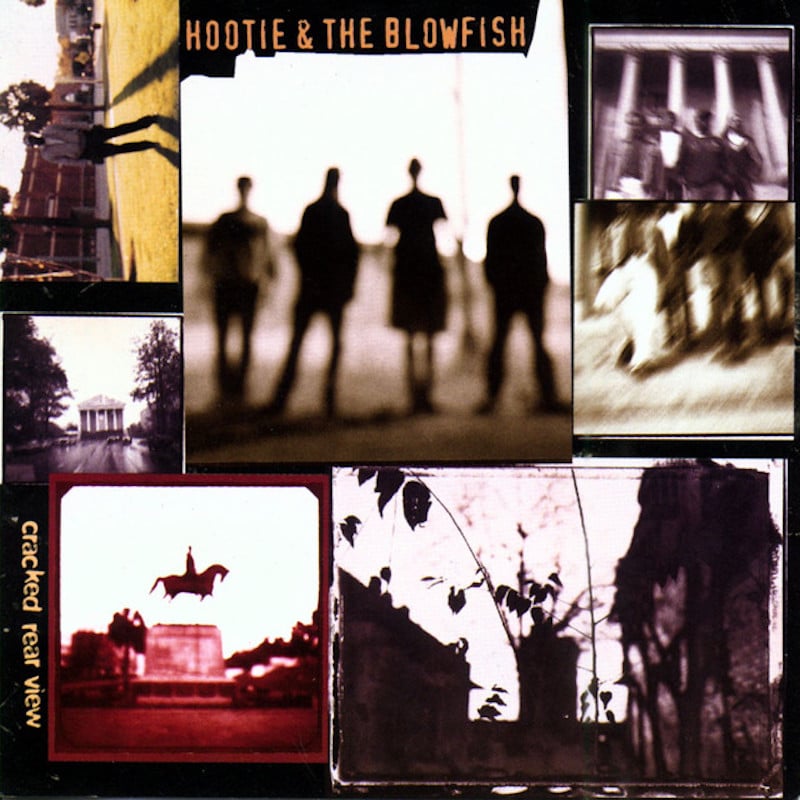Hootie & The Blowfish’s Cracked Rear View Turns 25

25 years ago, on July 5th 1994, bandmates Darius Rucker, Mark Bryan, Dean Felber, and Jim Sonefeld, under the moniker Hootie & The Blowfish, broke out of the keg fueled, hacky sack playing, college frat party scene, and plunged into the mainstream with their major label debut, Cracked Rear View. The album features twelve quintessentially 90s tracks that offered an indulgent escape from the angsty grunge tracks that dominated the decade.
By the time Hootie hit their stride in the mainstream in 1994, they had already been fine-tuning their brand of southern pop rock since their formation at Columbia SC’s University of South Carolina back in 1986. The story (one that now feels like on old southern wise tale) goes that guitarist Mark Bryan overheard frontman Darius Rucker singing in the communal showers of their USC dorm. The two began performing briefly as The Wolf Brothers before adding Dean Felber (bass) and Brantley Smith (drums) and settling on the ubiquitous Hootie And The Blowfish, that would carry them through the 90s and beyond.
Smith would eventually leave the band, and be replaced by Jim Sonefeld, rounding out the lineup that would eventually find its place as a college-rock powerhouse. The band cut their teeth at frat houses, tailgates and college bars across the country so that by the time their partnership with Atlantic Records began, the group already had a well-crafted sound and a following ready to receive a record that would rise to claim several coveted spots at the top of the charts.
The pop infused roots-rock tracks on Hootie & The Blowfish’s Cracked Rear View were released at a time where grunge music filled the pop radio airwaves. Along with Hootie’s debut, 1994 saw the release of Weezer’s Blue Album, Green Day’s Dookie, and Nirvana’s recording of their iconic MTV Unplugged performance among other influential releases that helped define a decade. Despite stiff competition, Hootie & The Blowfish managed to release an album whose 47-minute runtime was able to connect with an audience who wanted an escapist reprieve from the dark, and at times challenging the chart toppers of their contemporaries.
It’s been 25 years though, since the days of hair scrunchies, The Fresh Prince of Bel-Air, and Nintendo 64, and Cracked Rear View faces new obstacles to connecting with modern audiences. The album’s slick, major-label production doesn’t quite land the same way in 2019, when presented to listeners jaded by years of detached irony and a post-modern sensibility.
The album’s opener “Hannah Jane” gives listeners a taste of the insipid dad-rock textures to come, with its cliche drum and guitar tones. “Time’s” platitudinous picked guitar chords feel like they could be cut and paste onto any of the similarly stereotypical pop-rock records released in the decade without raising any eyebrows.
Even after considering all of its anachronistic production, it’s impossible to ignore the technical brilliance of Cracked Rear View. The album features inspired performances by proficient musicians, and slick production that made the album so widely enjoyed at the time of its release in 1994.
Some of the record’s lyrics also seem to fall victim to the same changes in listener’s palates over the last 25 years. In “Only Wanna Be With You”, perhaps the band’s most iconic chart-topper, Darius Rucker sings “I just want to love you but you wanna wear my ring / Well there’s nothing I can do / I only wanna be with you”. What may have felt like an earnest articulation of love of desire for connection in 1994, now feels a bit prosaic. Many of Cracked Rear View’s other major-label love songs hit listeners with a similar sense of just-add-water songwriting that doesn’t carry the same emotional weight that perhaps they once did.
The album does have some refreshingly poignant lyrical moments though. When the band decides to wade into more consequential thematic territory, they settle into something that’s pretty affecting, even to modern ears. The band, fronted by Rucker, a black man, considers race in “Look Away” through the lens of a woman whose father won’t let her date the song’s speaker. The result is moving, and showcases a particularly nuanced approach to songwriting that make some of Cracked Rear View‘s less inspired moments feel that much more frustrating.
With Cracked Rear View, Hootie & The Blowfish interjected itself into a musical conversation that was primarily governed by angsty grunge of the 90s, and made itself a household name for the rest of the decade and beyond. The far reaching musical implications of a record this influential is difficult to quantify. Despite its significance, in 2019 much of the album reaches listeners ears as, at best, a brief moment of nostalgia from a bygone musical moment. For all its antiquity though, Cracked Rear View does have something to offer for modern listeners in its refined, albeit inconsistent songwriting. 6/10.